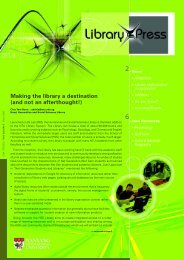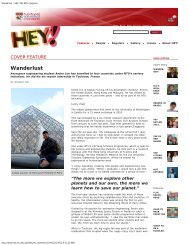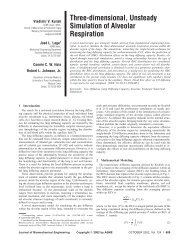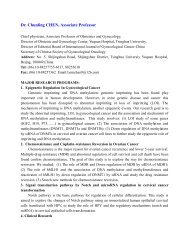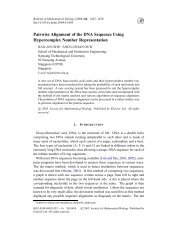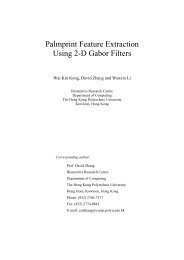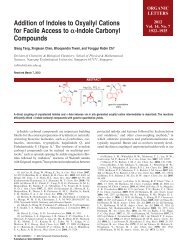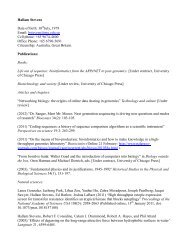Emotional reactions to scandals: When does moral character make ...
Emotional reactions to scandals: When does moral character make ...
Emotional reactions to scandals: When does moral character make ...
You also want an ePaper? Increase the reach of your titles
YUMPU automatically turns print PDFs into web optimized ePapers that Google loves.
JOBNAME: No Job Name PAGE: 7 SESS: 12 OUTPUT: Wed May 4 18:23:16 2011 SUM: 82F6234A<br />
/v2501/blackwell/A_journals/ajsp_v0_i0/ajsp_1344<br />
1<br />
2<br />
3<br />
4<br />
5<br />
6<br />
7<br />
8<br />
9<br />
10<br />
11<br />
12<br />
13<br />
14<br />
15<br />
16<br />
17<br />
18<br />
19<br />
20<br />
21<br />
22<br />
23<br />
24<br />
25<br />
26<br />
27<br />
28<br />
29<br />
30<br />
31<br />
32<br />
33<br />
34<br />
35<br />
36<br />
37<br />
38<br />
39<br />
40<br />
41<br />
42<br />
43<br />
44<br />
45<br />
46<br />
47<br />
48<br />
49<br />
50<br />
51<br />
52<br />
53<br />
<strong>Emotional</strong> responses <strong>to</strong> <strong>scandals</strong> 7<br />
disconfirmation when the participants’ estimations of<br />
perceived circulation differed from the feedback provided<br />
by the experimenter. Because perceived believability did not<br />
have an effect on emotional response <strong>to</strong> the scandal, we did<br />
not consider this fac<strong>to</strong>r in the present study.<br />
Measures. After responding <strong>to</strong> the perceived circulation<br />
measure, the participants completed the measures of emotional<br />
<strong>reactions</strong> <strong>to</strong> the scandal. Given the nature of the<br />
scandal, the participants might find it strange <strong>to</strong> report how<br />
much the scandal would evoke admiration and envy<br />
<strong>to</strong>wards Jackie Chan. Therefore, we considered negative<br />
emotional responses <strong>to</strong> the scandal only. Regarding the<br />
negative emotion measure, in addition <strong>to</strong> the two original<br />
negative emotion items (fear, angry), we added disgust,<br />
which is another major negative emotion <strong>to</strong>wards <strong>moral</strong><br />
indignity (Fiske et al., 2002). The reliability of the negative<br />
emotional response measure was 0.81. Finally, <strong>to</strong> evaluate<br />
the effectiveness of the impression manipulation, we had<br />
the participants respond <strong>to</strong> the manipulation check items<br />
used in the manipulation check study in Study 1.<br />
Results and discussion<br />
Manipulation check. The impression manipulation was<br />
successful. We performed a one-way ANOVA <strong>to</strong> evaluate<br />
the effect of the impression manipulation on the perceived<br />
<strong>moral</strong>ity of Jackie Chan. The effect of the manipulation was<br />
significant [F(2, 711) = 6.68, p = 0.001, h 2 p = 0.018].<br />
Jackie Chan was perceived <strong>to</strong> be more <strong>moral</strong> in the <strong>moral</strong><br />
<strong>character</strong> condition (M = 4.89, SD = 1.30) than he was in<br />
the denial of im<strong>moral</strong>ity condition (M = 4.52, SD = 1.29)<br />
[t(460) = 3.14, p = 0.002] or the denial of responsibility<br />
condition (M = 4.53, SD = 1.25) [t(497) = 3.17, p = 0.002].<br />
Furthermore, the perceived <strong>moral</strong>ity of Jackie Chan was<br />
significantly above the mid-point (4.50) in the <strong>moral</strong> <strong>character</strong><br />
condition only [t(297) = 4.76, p < 0.001].<br />
Preliminary analyses. The mean level of perceived cultural<br />
representativeness of Jackie Chan was 4.06 (SD = 1.26 on a<br />
scale of 1–7), which was significantly higher than that of<br />
Ge You in Study 1 [t(1239) = 10.66, p < 0.001]. The<br />
impression manipulation, which was introduced after the<br />
perceived cultural representativeness measure, did not have<br />
any impact on perceived cultural representativeness [F(2,<br />
711) = 0.21, p = 0.82].<br />
The mean level of perceived circulation was 29.95%<br />
(SD = 23.61%), which was lower than the actual percentage<br />
of participants who had heard of the scandal (38.7% 4 )<br />
[t(712) = 9.92, p < 0.001]. The impression manipulation<br />
did not have an effect on the perceived circulation of the<br />
scandal [F(2, 711) = 0.17, p = 0.84]. Perceived circulation<br />
of the scandal also did not correlate with the perceived<br />
cultural representativeness of Jackie Chan (r =-0.03).<br />
Taken <strong>to</strong>gether, the preliminary analysis results indicated<br />
that the impression manipulation, perceived circulation,<br />
and perceived cultural representativeness were orthogonal<br />
predic<strong>to</strong>rs in the current study.<br />
Effects of <strong>moral</strong>ity, cultural representativeness, and<br />
circulation. We hypothesize that making salient Jackie<br />
Chan’s concern with <strong>moral</strong>ity would be more effective for<br />
reducing negative emotions, only when Jackie Chan was<br />
perceived <strong>to</strong> be a cultural symbol and when the scandal was<br />
widely circulated. To test this hypothesis, we performed an<br />
impression ¥ perceived circulation ¥ perceived cultural<br />
representativeness GLM on negative emotions and predicted<br />
a significant three-way interaction. We mean-centred<br />
perceived circulation and perceived cultural representativeness<br />
<strong>to</strong> reduce the impact of multicolinearity.<br />
The predicted that the impression ¥ perceived<br />
circulation ¥ perceived cultural representativeness interaction<br />
was significant [F(2, 698) = 3.01, p < 0.05,<br />
h 2 p = 0.009]. To understand the nature of this interaction,<br />
we performed a separate circulation ¥ perceived cultural<br />
representativeness GLM in each impression condition. As<br />
in Study 1, in all impression conditions, there was a significant<br />
main effect of perceived cultural representativeness:<br />
F(1, 210) = 21.72, p < 0.001, h 2 p = 0.096 in the denial<br />
of im<strong>moral</strong>ity condition; F(1, 248) = 4.58, p < 0.001,<br />
h 2 p = 0.173 in the denial of responsibility; and F(1,<br />
240) = 9.06, p = 0.003, h 2 p = 0.036 in the <strong>moral</strong> <strong>character</strong><br />
condition. In all impression conditions, participants<br />
reported fewer negative emotions <strong>to</strong>wards Jackie Chan<br />
when they regarded him as more representative of Chinese<br />
culture (r between -0.15 and -0.31, p < 0.05). The main<br />
effect of circulation was not significant in any of the three<br />
impression conditions: F 1.03, p 0.31. More importantly,<br />
the circulation ¥ perceived cultural representativeness<br />
interaction was significant in the <strong>moral</strong> <strong>character</strong><br />
condition only: f(1, 240) = 6.84, p = 0.009, h 2 p = 0.028, and<br />
was f(1, 210) = 0.63, p = 0.43 in the denial of Im<strong>moral</strong>ity<br />
Condition and F(1, 248) = 1.47, p = 0.23 in the denial of<br />
responsibility condition.<br />
In Figure 2, we plot the predicted value of negative emotional<br />
responses when cultural representativeness was one<br />
standard deviation above (below) the mean and when the<br />
scandal was widely circulated or not in the <strong>moral</strong> <strong>character</strong><br />
condition. As in Study 1, when the impression that Jackie<br />
Chan valued <strong>moral</strong>ity was highlighted, the participants’<br />
emotional responses were least negative when the scandal<br />
was widely circulated and when Jackie Chan was seen as a<br />
representative of Chinese culture. <strong>When</strong> the scandal was<br />
widely circulated, emotional responses <strong>to</strong> Jackie Chan were<br />
less negative when he was seen as more representative of<br />
Chinese culture (B =-0.30, p < 0.001). In contrast, when<br />
the scandal was perceived <strong>to</strong> have low circulation, negative<br />
© 2011 The Authors<br />
Asian Journal of Social Psychology © 2011 Blackwell Publishing Asia Pty Ltd with the Asian Association of Social Psychology and<br />
the Japanese Group Dynamics Association<br />
54<br />
55<br />
56<br />
57<br />
58<br />
59<br />
60<br />
61<br />
62<br />
63<br />
64<br />
65<br />
66<br />
67<br />
68<br />
69<br />
70<br />
71<br />
72<br />
73<br />
74<br />
75<br />
76<br />
77<br />
78<br />
79<br />
80<br />
81<br />
82<br />
83<br />
84<br />
85<br />
86<br />
87<br />
88<br />
89<br />
90<br />
91<br />
92<br />
93<br />
94<br />
95<br />
96<br />
97<br />
98<br />
99<br />
100<br />
101<br />
102<br />
103<br />
104<br />
105<br />
106<br />
107



